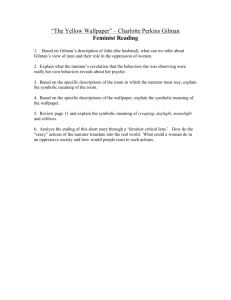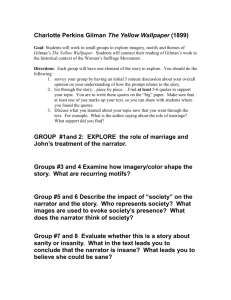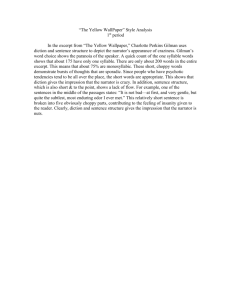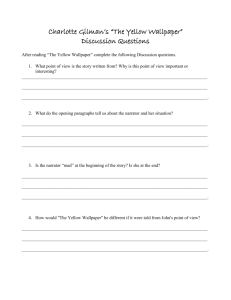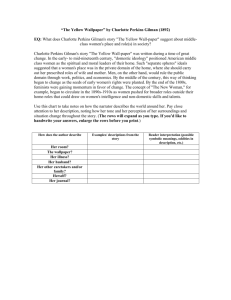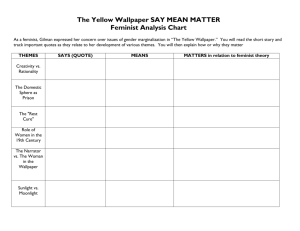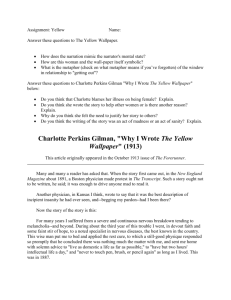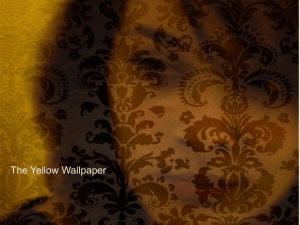"Yellow Wallpaper" Socratic prep
advertisement
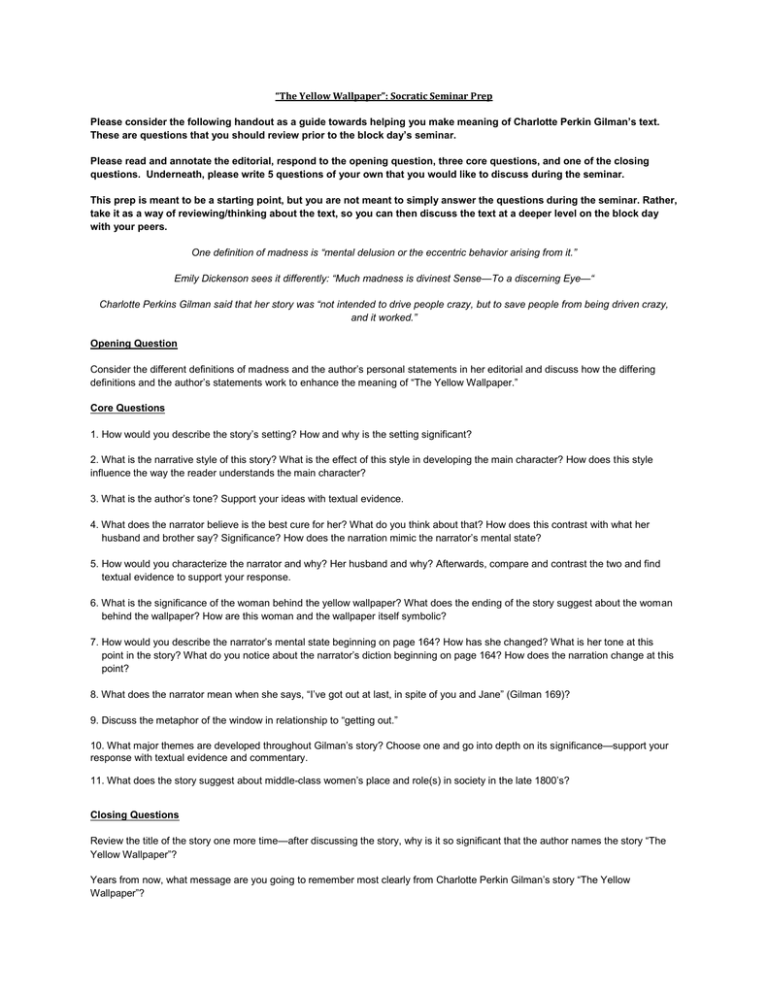
“The Yellow Wallpaper”: Socratic Seminar Prep Please consider the following handout as a guide towards helping you make meaning of Charlotte Perkin Gilman’s text. These are questions that you should review prior to the block day’s seminar. Please read and annotate the editorial, respond to the opening question, three core questions, and one of the closing questions. Underneath, please write 5 questions of your own that you would like to discuss during the seminar. This prep is meant to be a starting point, but you are not meant to simply answer the questions during the seminar. Rather, take it as a way of reviewing/thinking about the text, so you can then discuss the text at a deeper level on the block day with your peers. One definition of madness is “mental delusion or the eccentric behavior arising from it.” Emily Dickenson sees it differently: “Much madness is divinest Sense—To a discerning Eye—“ Charlotte Perkins Gilman said that her story was “not intended to drive people crazy, but to save people from being driven crazy, and it worked.” Opening Question Consider the different definitions of madness and the author’s personal statements in her editorial and discuss how the differing definitions and the author’s statements work to enhance the meaning of “The Yellow Wallpaper.” Core Questions 1. How would you describe the story’s setting? How and why is the setting significant? 2. What is the narrative style of this story? What is the effect of this style in developing the main character? How does this style influence the way the reader understands the main character? 3. What is the author’s tone? Support your ideas with textual evidence. 4. What does the narrator believe is the best cure for her? What do you think about that? How does this contrast with what her husband and brother say? Significance? How does the narration mimic the narrator’s mental state? 5. How would you characterize the narrator and why? Her husband and why? Afterwards, compare and contrast the two and find textual evidence to support your response. 6. What is the significance of the woman behind the yellow wallpaper? What does the ending of the story suggest about the woman behind the wallpaper? How are this woman and the wallpaper itself symbolic? 7. How would you describe the narrator’s mental state beginning on page 164? How has she changed? What is her tone at this point in the story? What do you notice about the narrator’s diction beginning on page 164? How does the narration change at this point? 8. What does the narrator mean when she says, “I’ve got out at last, in spite of you and Jane” (Gilman 169)? 9. Discuss the metaphor of the window in relationship to “getting out.” 10. What major themes are developed throughout Gilman’s story? Choose one and go into depth on its significance—support your response with textual evidence and commentary. 11. What does the story suggest about middle-class women’s place and role(s) in society in the late 1800’s? Closing Questions Review the title of the story one more time—after discussing the story, why is it so significant that the author names the story “The Yellow Wallpaper”? Years from now, what message are you going to remember most clearly from Charlotte Perkin Gilman’s story “The Yellow Wallpaper”? If you had the opportunity to speak to the author and ask her one question about her story, what would you want to ask her? Why? "Why I Wrote The Yellow Wallpaper" (Charlotte Perkins Gilman) Many and many a reader has asked that. When the story first came out, in the New England Magazine about 1891, a Boston physician made protest in The Transcript. Such a story ought not to be written, he said; it was enough to drive anyone mad to read it. Another physician, in Kansas I think, wrote to say that it was the best description of incipient insanity he had ever seen, and-begging my pardon--had I been there? Now the story of the story is this: For many years I suffered from a severe and continuous nervous breakdown tending to melancholia--and beyond. During about the third year of this trouble I went, in devout faith and some faint stir of hope, to a noted specialist in nervous diseases, the best known in the country. This wise man put me to bed and applied the rest cure, to which a still-good physique responded so promptly that he concluded there was nothing much the matter with me, and sent me home with solemn advice to "live as domestic a life as far as possible," to "have but two hours' intellectual life a day," and "never to touch pen, brush, or pencil again" as long as I lived. This was in 1887. I went home and obeyed those directions for some three months, and came so near the borderline of utter mental ruin that I could see over. Then, using the remnants of intelligence that remained, and helped by a wise friend, I cast the noted specialist's advice to the winds and went to work again--work, the normal life of every human being; work, in which is joy and growth and service, without which one is a pauper and a parasite--ultimately recovering some measure of power. Being naturally moved to rejoicing by this narrow escape, I wrote "The Yellow Wallpaper," with its embellishments and additions, to carry out the ideal (I never had hallucinations or objections to my mural decorations) and sent a copy to the physician who so nearly drove me mad. He never acknowledged it. The little book is valued by alienists and as a good specimen of one kind of literature. It has, to my knowledge, saved one woman from a similar fate--so terrifying her family that they let her out into normal activity and she recovered. But the best result is this. Many years later I was told that the great specialist had admitted to friends of his that he had altered his treatment of neurasthenia since reading The Yellow Wallpaper. It was not intended to drive people crazy, but to save people from being driven crazy, and it worked. __________________________________________________ SOURCE: The Forerunner, October 1913.

